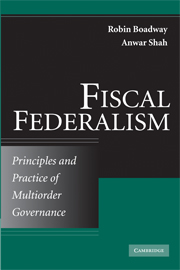Book contents
- Frontmatter
- Contents
- Preface
- PART ONE DESIGNING FISCAL CONSTITUTIONS
- PART TWO REVENUE SHARING AND FISCAL TRANSFERS
- PART THREE FINANCE AND PROVISION OF PUBLIC SERVICES
- 11 Finance and Provision of Health and Education
- 12 Finance and Provision of Infrastructure
- 13 Poverty Alleviation in Federations
- PART FOUR CHALLENGES AND RESPONSES
- References
- Index
13 - Poverty Alleviation in Federations
Published online by Cambridge University Press: 05 June 2012
- Frontmatter
- Contents
- Preface
- PART ONE DESIGNING FISCAL CONSTITUTIONS
- PART TWO REVENUE SHARING AND FISCAL TRANSFERS
- PART THREE FINANCE AND PROVISION OF PUBLIC SERVICES
- 11 Finance and Provision of Health and Education
- 12 Finance and Provision of Infrastructure
- 13 Poverty Alleviation in Federations
- PART FOUR CHALLENGES AND RESPONSES
- References
- Index
Summary
Along with education and health care, poverty alleviation programs constitute the most important social programs in developing countries. The current strategy for development endorsed in many countries involves a two-pronged approach. On the one hand, a necessary condition for development is an increase in per capita incomes, which is best achieved by encouraging private investment and taking advantage of market processes. The role of developing-country governments in this context is largely one of policy reform – eliminating unnecessary regulations, rationalizing the tax system, deregulating input and output prices, reducing trade protection, and removing public enterprise presence in industrial sectors. These reforms also go hand in hand with better governance by reducing the opportunities for bureaucratic rent seeking in market activities and outright corruption.
At the same time, high growth rates themselves are not sufficient to achieve the objectives of development, which include reducing the incidence of poverty. That is because the fruits of growth do not accrue uniformly across the population. In the absence of corrective intervention, there is a danger of the poorest groups in society falling even further behind. Thus, complementary policies aimed at uplifting the least fortunate in the society are required. In fact, the two objectives of economic growth and poverty alleviation are not conflicting, because higher growth provides the resources for poverty alleviation. Moreover, if poverty alleviation policies are well structured, they need not be a drag on growth: indeed, by improving the well-being of the least well-off, the quality of the work force is improved.
- Type
- Chapter
- Information
- Fiscal FederalismPrinciples and Practice of Multiorder Governance, pp. 445 - 460Publisher: Cambridge University PressPrint publication year: 2009

